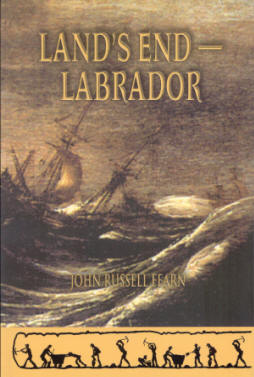John Russell Fearn, Land’s End — Labrador
reviewed by David Redd

Publisher: The Battered Silicon
Dispatch Box, 2005
Hardcover: $28
ISBN: 1-55246-552-7
Paperback: $16
ISBN: 1-55246-553-5
Length: 150 pp.
If you think the book sounds interesting and you’re in a position to purchase it — I bought the trade paperback, a handsome production — you may care to do so and then try to answer this double question:
1. The Toronto Star Weekly, with a mainly female Canadian readership, published over 30 sf novels by Fearn. Why did they reject this one?
2. What unexpected strength of imagination can you discover in this novel?
Those of you not pausing to take up the full Challenge, please read on.
Land’s End — Labrador revives pre-war pulp traditions of storytelling as our hero, tough engineer Boyd Exmoor, tunnels 2,500 miles under the Atlantic. (Not single-handed.) Fearn was writing before the discovery of plate tectonics, but nevertheless threw in enough geological and human hazards to keep his story moving briskly.
His chosen technique here was near-documentary realism, plus a little speculative science in places. This was remarkably low-key for an author whose other creations included an avenging Martian, descendants of Atlantis, a golden-haired superwoman, a mad dictator splitting the world in two, etc etc. The novel uses a few dated storytelling conventions such as stock characters, but those old techniques were still acceptable in the Fifties. So why did the Star Weekly reject this book?
Was its plain writing style the reason? Hardly. Vincent Clarke met Fearn at a 1954 convention and commented, “Fearn has a drily humorous and likeable personality which appears far too infrequently in his stories,” yet Fearn sold over 300 stories and novels in his plain but smooth prose. Clearly, style was not the problem! No, I think the trouble was something even more basic — something all writers should beware of.
Fearn, wishing to pay homage to the early pulp writers, simply failed to consider his current market. His Star Weekly readers were typically Canadian women for whom his “Golden Amazon” series offered thrilling visions of female empowerment.
Here, though, he neglected both Canada and the women. Most of this narrative was male-centred, showing Boyd Exmoor tunnelling west from Land’s End. Surely his readers would have preferred more focus on Boyd’s Canadian counterpart Judith Saunders tunnelling east — a woman engineer succeeding in a man’s world?
And similarly, wouldn’t they have preferred the Labrador setting as both exotic and Canadian? These simple changes would have made the novel much stronger and much more likely to sell, even if the actual plot and incidents remained unchanged.
Curiously, were Fearn writing this novel today, his tunnelling scheme of start-at-each-end to meet in the middle might provide an unforeseen plot bonus. At the Mid-Atlantic Ridge, scientists have identified tectonic plate movements and volcanic activity, huge geological obstacles offering a potential Very Big Finish for the story.
Which leads on to the second part of this Challenge. What else about Land’s End — Labrador seems unexpectedly successful today? If you have read the book, I hope you noticed how certain background details appear strangely modern.
P. 73: When insufficient Englishmen sign on for dangerous tunnelling work, Exmoor recruits eastern Europeans, exactly as has happened in Britain in the last few years, with economic migrants taking on work which unemployed Brits refuse to do.
P. 100: “Money was swallowed up in staggering amounts, making the original budget seem ridiculous.” Another modern detail, which applies to the real-life England-France tunnel, the UK 2012 Olympic Games bid, and much else.
P. 109: Judith Saunders suffers dehumanisation and possible burnout from the demands of the project — a recognised problem now in highway “lane rental” work and other high-stress construction activities.
P. 142: To keep the tunnel bore going, a publicity campaign builds support. “In fact the essence of the propaganda was nothing but clever mumbo-jumbo” — a technique familiar in current UK politics and termed “spin-doctoring.”
P. 178: The tunnelling takes two years, but “the original ten years allowed for the project were swallowed up in completing the final details” of rail routes, stations, etc. Again, a good realistic touch echoed in several recent construction projects.
One success could be a lucky guess; a whole series of them shows that Fearn did rather well with his general observations of how society works. Interestingly, most of the novel’s real strengths — these observations, Judith’s struggles — occur in the second half of the book, when Fearn was more fully immersed in his created world. Clearly, in writing sf, the thinking time is as important as the writing time.
I commend Land’s End — Labrador as a valuable, instructive and enjoyable text. The book also includes detailed prefatory essays by John Robert Colombo and Philip Harbottle.
* * *
Note: Fearn’s legacy lives on in other ways. The “Golden Amazon” series referred to above is being reprinted and continued; veteran UK author John Glasby recently sold two new Amazon novels to Gryphon Books. Check their website, and of course that of The Battered Silicon Dispatch Box.
Copyright © 2007 by David Redd

